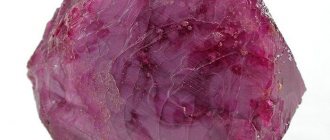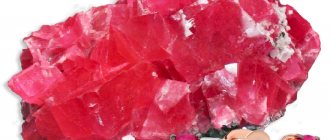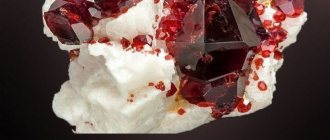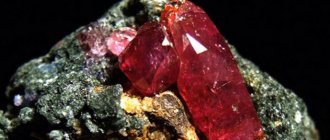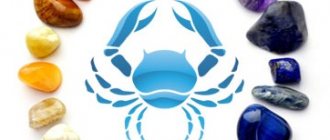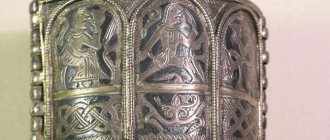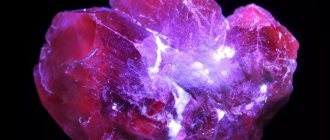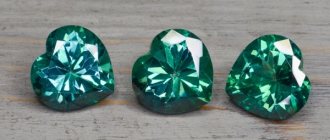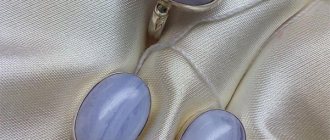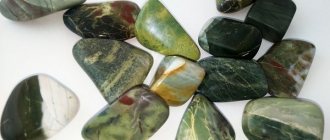Ruby is an expensive red gemstone with a high degree of transparency. Its cost can range from a few hundred dollars to tens of thousands of dollars, depending on the size and purity.
Even people with above-average income cannot always afford jewelry with rubies, since high-quality rubies are rare in nature. But today, artificial rubies are used in the jewelry industry. These are beautiful, bright stones with a high degree of transparency, and jewelry with them turns out catchy and luxurious. But not everyone knows how synthetic rubies differ from natural ones. Therefore, let's get to know them better.
Natural ruby
Ruby is a type of corundum. These also include sapphires. Ruby is the name given to those corundums that are red, crimson, crimson, reddish-violet, deep lilac and red-brown in color. Stones that are too light, pink and light pink are classified as pink sapphires.
Although technically, ruby and sapphire are identical in composition. Their formula is AI2O3. The color difference is only due to different impurities. The red color of ruby comes from chromium compounds.
Corundums are the second hardest of all natural stones (9 on the Mohs scale). They are second only to diamonds.
Rubies are very beautiful. They shine beautifully and shimmer brightly when illuminated. Transparent rubies are most often seen in jewelry. However, there are also rarer representatives of red corundums - opaque, with the effect of asterism (star-shaped, when impurities form rays) and “cat's eye” (one ray).
The price of rubies is impressive. A refined stone of sufficient purity sells for $500-600 per carat. Rare stones, with a high degree of transparency or with the effect of asterism, will cost ten times more.
A real ruby is very expensive! What are you giving me here?!
Many people who want to purchase precious stones and products with them are very distrustful of relatively low prices and, even more so, are afraid of overpaying a round sum for a fake. And it is right!
In this article, I want to highlight the topic of purchasing rubies and share with you knowledge on how you can protect yourself from a purchase that does not meet your expectations.
Imitations, synthetics and other troubles.
It is very difficult for the average person to distinguish natural stone even from glass, and even more so from high-quality synthetics.
Why am I writing about synthetics and not using the term “imitation”?
Because imitation is a fake of something when other materials imitate the original in appearance.
Synthetics, on the other hand, are not an imitation, because they are completely identical to the original and have the same chemical composition and physical properties.
glass can be an imitation of ruby . But, when compared externally with a natural mineral, it is clear that it has an unnaturally uniform rich color and a “cheap” shine. All the highlights of the edges will be the same shade (which is also typical for synthetics). Glass is much lighter and softer than ruby.
Glass is still rarely passed off as large natural stones, but you need to be careful with small sprinkles! With a stone size of 1-2mm, it is difficult to determine its naturalness from a photo. In this case, you need to pay attention to whether the shades of the stones are different. Natural stones will not be exactly the same color and saturation.
More often, other semi-precious stones, such as garnet and red tourmaline, are passed off as rubies.
However, this is not always beneficial, because... high-quality red tourmaline, rare types of garnet, as well as natural ruby spinel will cost more than glass-filled ruby (information about this type of refining of natural stones will be given below).
All of these stones have a lower hardness (on the Mohs scale) and different numerical indices of light refraction (determined by a refractometer) than ruby.
Of course, it is impossible to determine all this from a photo, but, with a certain “observation,” it is possible to distinguish them from rubies by color, shine and inclusions.
The photo below, for example, shows rubellite tourmaline (unlike ruby, it does not fluoresce) and pyrope garnet (can be confused with brownish, iron-rich Thai ruby, but, unlike it, has a homogeneous structure).
The situation is more complicated with synthetic ruby . In its composition and properties it is completely identical to natural stone.
And if the synthetics of the “pre-Soviet” and “Soviet” periods are stones of ideal purity that are easy to identify by their price, because... natural rubies of similar quality cost thousands of dollars per carat (all pink and red rubies in jewelry from the times of the USSR are synthetic!), but modern synthetics will be more difficult to distinguish “by eye”.
Modern methods of production and subsequent refining of rubies make it possible to create inclusions in the stone, which for many serve as an indicator of the naturalness of the stone.
You can try to distinguish Chinese and Indian imitations, as well as modern synthetics with inclusions, from the photo if the seller provides you with it of good quality.
Of course, the average person will not be able to distinguish flux inclusions in a synthetic ruby from gas-liquid inclusions in a natural stone, even with a magnifying glass, let alone a photo. But some obvious signs are often immediately visible.
Ruby is synthetic or imitation (often colored quartz) if:
1- all inclusions in the stone are of the same shape and color and are evenly distributed in the space of the stone
2- inclusions are clusters of transparent small bubbles in the form of waves, intertwined and reminiscent of puffs of smoke
3- the filler of the cracks of the stone is darker than its main color (in natural sapphires refined with glass filling, this is possible, in rubies - not, unless it is colorless corundum culling impregnated with dye).
4- the stone has ideal purity and rich color
5- all inclusions in the stone are of the same light color (when viewed through a magnifying glass, such inclusions will appear as small transparent bubbles), while the main color of the stone is uniform, without halftones.
6- the stone has internal cracks in the form of a large mesh
Below you can see photos of such stones.
Colored quartz or corundum. The accumulation of dye in the cracks is visible.
Inclusions that look like waves or puffs of smoke
White fluid inclusions in hydrothermally grown synthetic ruby
There are no inclusions in the stone, all highlights of the stone are of the same shade
Internal cracks in the form of a mesh (honeycomb)
So what are they then, NATURAL rubies?
And why are they so cheap? Is there some kind of catch?
Yes and no…
Rubies have four main quality indicators: color, clarity, weight, and cut quality.
Unlike diamonds, color is the determining factor.
Defect groups for rubies can easily be found on the Internet.
But, if we are talking about buying a ruby, the price tag of which is “x” thousand rubles, and not dollars, then it is not worth delving into these indicators..
In addition to the characteristics of the stone listed above, its cost is greatly influenced by the method of its refining. Or rather, it doesn’t even affect, but divides it into three categories:
1- Rubies N - unrefined faceted stones (rare, but can be found on the open market with low quality indicators)
2- Rubies H - stones refined by heat (stones are heated to high temperatures to enhance color, due to the dissolution of internal inclusions, and purity)
3- Rubies F - glass-filled rubies (stones that are initially pale and fractured are heated in a mass of glassy substances that seal the cracks and pores)
So it is the third type of rubies that is found on store shelves in 99% of cases! And it is precisely such stones that can cost thousands and even hundreds of rubles, not dollars!
It turns out that’s where the catch is! Stones are half glass, they are short-lived and fragile!
— These exclamations can be seen on many websites and forums. Some “experts” claim that such a ruby will fall apart even if you swim with it in sea water...
But is everything so pessimistic?
Let's not believe unfounded statements, but let's understand the physics of the process.
Debunking myths and judgments.
It is believed that rubies that are “annealed for color” do not contain any glassy substances in the cracks and pores.
This is actually a false statement! Because all stones are annealed in a liquid flux and gas environment, the components of which can form glassy compounds, microdefects in the crystals are filled with this mass. Therefore, the division of rubies into “only heated” and “filled with glass” is very arbitrary and rather a marketing ploy.
The question is the percentage of this “glass” in the stone. This is what determines the quality and cost of category F rubies.
If there is a lot of “glass” in a ruby (more correctly, lead oxide), then such stones have a high concentration of cracks and other defects, they are cloudy and do not have an internal shine.
But if the stone is sufficiently transparent, the internal edges reflect light rays and the cracks are not noticeable to the naked eye, then such a ruby is considered high quality in its category and is not inferior in appearance to H and even N rubies and its price will not be “budgetary”.
Regarding strength, the process of healing cracks is irreversible. The stone will not crack, will not deteriorate from sea water, and will not fade in the sun. Unless, of course, you hit it with a hammer, throw it into the fire and pour acid on it, then it will delight you for many decades.
I would like to note that when taking a bath, house cleaning and other activities that bring your jewelry into contact with an aggressive chemical environment, it is better to remove any jewelry, regardless of the type of stone enhancement.
Now all that remains is to deal with the inclusions in natural rubies in order to distinguish them from fakes.
Inclusions and microdefects in natural rubies.
Natural rubies can be identified from photographs by the following characteristics:
1- the color in the space of natural stone is distributed unevenly due to microdefects
2- the inner edges of the stone, when light hits them, will have highlights of different color tones
3- defects in natural stones are heterogeneous and more often have a linear orientation, internal stresses are similar to brush strokes or fibers, but never form a continuous diamond-shaped lattice
4- the color of inclusions can be red (iron impurities), black (graphite), dark red, brown
5- inclusions can be in the form of streaks on the glass and fingerprints, but never in the form of white round bubbles.
6- the space of heated and glass-filled rubies is similar to fruit jelly with many bubbles (bubbles are formed in the crack filler, they are always dark in color, matching the stone), flakes, zigzag cracks, clouds of “red cotton wool”
7- microdefects are imperfect and unevenly distributed inside the crystal
Below are photos of natural stones with various types of enhancement
Unrefined ruby N with undissolved natural inclusions. Inhomogeneity of color is visible.
Ruby N with zigzag internal crack
Ruby N with parallel oriented internal cracks
Ruby F. The photo shows bubbles of various shapes, flakes and “red cotton wool”
Ruby F cabochon is of low quality, opaque. Parallel stripes of inclusions, flakes, and bubbles are visible.
Ruby F. good quality. Minimum cracks and inclusions. Flakes and “red cotton wool” are visible
Bright heated ruby F. A network of microcracks is visible on the surface.
Ruby graded H. Heated with no signs of glass filling.
The surface of such rubies is smooth, without a network of microcracks.
In the article I did not touch on the topic of “star” rubies. I can briefly say that they have now learned how to make a “star” in synthetic corundum. And you need to be careful with stones with a rich, uniform color and a bright, perfectly even star.
I hope the information presented will help you navigate the many available options for jewelry with rubies and protect you from buying fakes.
Add to favorites so you don't lose!
PS: I tried to present all the information in the most accessible form for the buyer, please do not throw professional gemologists at me.
What stones are confused with ruby?
How to distinguish a natural and artificial ruby? Here you need to understand that jewelry may contain not only natural and synthetic red corundum, but also other stones that may try to pass off as rubies. For example it could be:
- Almandine is a hard garnet. But it is inferior in strength to corundum.
- Pink and red spinel.
- Pink topaz. Jewelers call it “Brazilian ruby”.
- Cuprite. Stone made of copper compounds.
- Red tourmaline. You can also hear the name “Siberian ruby”.
- Red sphalerite. Rock stones found in Spain.
- Rose quartz.
- Composite red corundum. Natural stone is fused with glass to increase size and weight, and therefore cost.
- Red glass. The cheapest imitation corundum.
All of these stones and materials have a hardness lower than that of ruby.
Not everything can be faked
It is impossible to fake “star” rubies, which have the property of asterism. The samples are processed in the form of a cabochon and a six-pointed star appears on the convex surface in daylight. If such a ruby is owned among jewelry, then you can be sure of its authenticity.
The ruby gemstone has a luxurious appearance and is worn only in gold. Imitation material does not replicate the amazing properties of natural gemstones. You can protect yourself from purchasing a fake by studying the features of the stone or enlisting the help of a good jeweler.
Synthetic ruby - fake or precious stone
Artificial rubies are often found in jewelry. At the same time, sellers do not mention that the corundum in the product was synthesized and call it natural. Are they deceiving the buyer or not?
Technically, still no. Natural and artificial rubies have the same chemical composition and absolutely identical properties. They have the same hardness. At the same time, synthetic stone is cleaner and has higher transparency, since there are no various inclusions. But natural stones are more expensive.
Unmasking with a magnifying glass
When going to a jewelry store for a luxury purchase, you can take a magnifying glass with 10x magnification.
If you look at a natural ruby through such a magnifying glass, you can see clear edges that do not blur under high magnification. If the clarity of the edges is impaired, then you have a synthetic stone in your hands.
If you carefully examine the ruby through a magnifying glass, you can see small air bubbles. In a real gem, they will have the same color as the stone. In “synthetics” the bubbles are colorless and transparent.
Ruby samples of any quality class have defects in the form of scratches and streaks in varying quantities. In a natural stone, all inclusions have a zigzag shape, while in a fake, they are smooth.
The history of obtaining synthetic ruby
Synthetic corundum is also called hydrothermal. The first artificial corundum was born thanks to the work of Mark Gooden in 1837. However, there was no rush to adopt his successful experience. At that time, the very idea that people of modest means could wear jewelry was a crime in the eyes of the aristocracy.
Then, 50 years later, reconstructed rubies were obtained. They were melted from crumbs and fragments of natural corundum, so they cannot be called synthetic.
And finally, in 1892, a real breakthrough occurred. The Frenchman Auguste Verneuil completely abandoned the use of natural corundum and produced a synthetic stone made from aluminum oxide.
Receipt methods
Today, artificial ruby stones can be obtained using several technologies:
- Verneuil's method. Growing crystals.
- Czochralski method. It is based on the synthesis of corundums by extracting them from the surface. The process begins with the introduction of a crystal with an already established lattice structure into the zone. Most often, silicon and germanium are obtained in this way. But with a little modernization, other crystals can be produced.
- Zone melting. One of the variations of directional crystallization. Primarily used to separate solids from impurities.
- Crystallization from solutions. Corundums are grown from solutions, and the process occurs at temperatures lower than when minerals crystallize from molten raw materials. This produces cleaner stones with brighter colors.
- Obtaining corundum from raw materials in a gaseous state. The method is used to produce large corundums.
- Hydrothermal method. Artificial ruby is obtained from alumina, silica and chromium compounds. They are placed in a melting crucible and then in an autoclave. Under the influence of high temperatures, the crystals mature. Then the temperature regime is changed, and depending on this, stones of different shapes, colors and purities are obtained.
Thanks to modern methods of synthesizing crystals, it is possible to obtain artificial corundum in a few minutes.
Basic modern methods of growing rubies
Today, only modern methods of growing crystals are used, where attention is mainly paid to the speed of obtaining finished specimens. Methods are distinguished:
- Vernel method - the manufacturing principle is to mix chromium and aluminum oxide. As a result, after melting, a cylindrical crystal is formed.
- Czochralski method - mined by pulling a seed crystal upward from the surface of a large volume of starting material. This method of preparation produces very large crystals.
- Zone melting method - the method is similar to the previous method, but pulling occurs along the heating element. The result is a plate-shaped crystal.
- Garnissage melting - the substance melts and crystallizes, while its own cold zones are located around it. Heating occurs by radiation, which results in columnar specimens.
- Hydrothermal synthesis is used exclusively for the manufacture of jewelry crystals. To obtain it, a solution of a more fusible substance is used. The result is large specimens.
The method of obtaining crystals pleases with its advantages and disappoints with its disadvantages, so the most convenient and suitable for the targeted formation of specimens is chosen.
Synthetic corundum has a right to its existence, and should not be abandoned. If you want to purchase voluminous jewelry, but at an attractive and affordable price, it is better to choose an artificially produced ruby rather than buy a fake in the form of painted glass.
Features of artificial stone
Artificially grown ruby has a number of features that distinguish it from the natural mineral. The color of synthetic stone is several times brighter. Over time, synthetic stone does not fade, unlike natural stone.
Artificial rubies are free of flaws. They do not contain foreign inclusions, and nothing overshadows their shine and purity.
The color of synthetic corundum can be any. At one stage of production, they are all colorless. But then chromium, vanadium and iron compounds are added to them. The palette of shades obtained is almost richer than that of natural stones. Red-violet rubies (“pigeon blood”) are very popular. The effects of asterism and “cat's eye” are not a guarantee of natural origin. They can also be obtained artificially.
Light to the rescue
In the event that you don’t have a magnifying glass at hand, and the store salesperson refuses to provide it, casting doubts about the authenticity of the product, you can try playing with light.
Natural stone, exposed to the rays of sunlight, will reveal all its incredible beauty. The side that is illuminated by the sun will exude an amazing burgundy shine. On the reverse side, the surface will remain matte with a pale glow.
If you have an ultraviolet flashlight with a wavelength of 280 nm at your disposal, then you can dedicate it to the ruby. The original stone will not change the color of the glow, it will remain red. The imitation will sparkle with orange tones when exposed to ultraviolet light.
The “pigeon’s blood” effect, characteristic of real rubies, is clearly visible when the product is turned in different directions in daylight. The gem shimmers with purple hues. Imitation material does not have this effect.
For reliable results, you can use two testing methods simultaneously - viewing the sample through a magnifying glass and in sunlight.
How to distinguish a natural ruby from an artificial one
The problem is that the properties and characteristics of both minerals are identical. They have the same hardness and other physical characteristics. However, their prices vary and a synthetic crystal is much cheaper than a natural one. How to distinguish artificial rubies? To do this, you can use the following methods:
- Synthetic corundum loses color under an ultraviolet lamp. Any natural crystal retains its original light. This is practically the only true way to distinguish a natural crystal from an artificial one.
- There is an opinion that natural stone has a more intense natural glow. Therefore, to check, they dipped the ruby into milk. If it turns pinkish, it means the stone is real.
- Synthetic corundums are slightly lighter than natural ones. However, without special instruments and the availability of a large number of samples for comparison, it is impossible to determine the origin of the stone. Although a jeweler can almost immediately determine this by weight.
- Natural stone has many inclusions, cracks, bubbles and other defects. Crystals that are too pure are rare in nature.
- Synthetic stones also have bubbles. They are large and whitish. In natural stones, the bubbles are filled with a red gaseous substance.
- Natural stone has a rich color when illuminated from any side. The artificial one becomes pale on some edges.
Checking at home
There are several interesting methods to help determine the authenticity of the purchased stone at home. It’s better to try them together for a full analysis:
- Place it in a transparent glass of water and if it does not start playing with red rays, then this is not a real stone.
- You can put it in a glass of milk. Natural specimens give milk a pinkish tint due to pronounced color refraction.
- Hold the mineral in your palm. If it maintains its original temperature for a long time, then this is a natural gem.
- Take the needle and move it firmly across the pebble. If it remains intact, it means you made the right purchase. If there is a scratch, then this is a fake.
- High density determines the severity of the mineral. Small natural stones weigh significantly heavier than ordinary painted glass.
Magical and healing properties
Natural rubies have been valued at all times for their mystical properties. It was believed that they quickly give energy to a person or take away its excess. With the help of a ruby or yakhont, as it was called in the old days, it was determined whether food was poisoned or not. To do this, the crystal was lowered into a bowl and watched to see if the color of the food changed.
Many people still believe that rubies attract wealth and good luck.
However, modern mystics are convinced that synthetic rubies do not have any magical properties.
Price and features
Ruby is the second most important gemstone after diamond. It also has high density and strength. Its edges shimmer in the light with a glow. True, not white, like diamonds, but red. It seems that you can watch these overflows forever. The cost of rubies is close, and in some samples even equal to the cost of diamonds.
Therefore, when going to a jewelry salon, you should be well prepared for your purchase. Because ruby is not very common in nature, and modern industry is not asleep. People have learned to produce artificial rubies. In addition, the thirst for profit pushes some sellers to offer other minerals, or even glass, under the guise of ruby.
Natural ruby faceted
To figure out what is offered to you in the salon, you should arm yourself with a tenfold magnifying glass and an ultraviolet flashlight. You can also bring a glass jar or glass from home.
What you need to know when buying jewelry with stones
Many buyers worry about buying a brooch or ring with an artificial ruby instead of a natural one. In order not to accidentally purchase jewelry with synthetic corundum, you need to remember the following:
- If a seller calls a stone natural, but in reality it turns out to be synthetic, then this is a direct deception of the consumer.
- You should always require a quality certificate for a stone. They often indicate where and how the crystal was obtained.
- You may need to check it under ultraviolet light - an artificial ruby will discolor in the rays, while a natural one will retain its color.
A little history
Ruby gained fame in ancient India, where it was considered the king of precious stones.
The Greeks and Romans also highly valued ruby and believed that the stone promoted victories and great feats, so the palaces of rulers and their clothes were often decorated with ruby items. In eastern countries, the stone personified vital energy, and its owners received love, strength and health. In Rus', the gem became popular in the 9th century and was called yakhont (like its “brother” sapphire). It was believed that the stone gives strength and heals the heart. And since “yakhontovy” used to be a synonym for “precious”, the expression “you are my yakhontovy” was adopted among the people as an address to a dear, beloved person. Photos of the ruby stone demonstrate its unsurpassed majesty and mystery.
